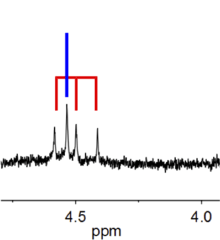Isotopic shift
The isotopic shift (also called isotope shift) is the shift in various forms of spectroscopy that occurs when one nuclear isotope is replaced by another.
Atomic spectra
Isotope shifts in atomic spectra are minute differences between the electronic energy levels of different isotopes of the same element. Today they are the focus of a multitude of theoretical and experimental efforts due to their importance for atomic and nuclear physics. If atomic spectra also have hyperfine structure the shift refers to the center of gravity of the spectra.
From a nuclear physics perspective, isotope shifts combine different precise atomic physics probes for studying nuclear structure, and their main use is nuclear-model-independent determination of charge-radii differences.
There are two effects which contribute to this shift:
- The mass difference (mass shift), which dominates the isotope shift of light elements[1]. It is traditionally divided to a normal mass shift (NMS) resulting from the change in the reduced electronic mass, and s specific-mass-shift (SMS) which is present in multi-electron atoms and ions. The NMS is a purely kinematical effect, studied theoretically by Hughes and Eckart[2]. The effect of the specific mass shift was first observed in the spectrum of neon isotopes by Nagaoka and Mishima[3].
- The volume difference (field shift), which dominates the isotope shift of heavy elements. This difference induces a change in the electric charge distribution of the nucleus. This effect is important in heavy elements and its first theory was formulated by Pauli and Peierls.[4][5][6]. Adopting a simplified picture, the change in an energy level resulting from the volume difference is proportional to the change in total electron probability density at the origin times the mean-square charge radius difference.
NMR spectroscopy
In NMR spectroscopy, Isotopic effects on chemical shifts are typically small, far less than1 ppm the typical unit for measuring shifts. The 1
H NMR signals for 1
H
2 and 1
H2
H ("HD") are readily distinguished in terms of their chemical shifts. The asymmetry of the signal for the "protio" impurity in CD
2Cl
2 arises from the differing chemical shifts of CDHCl
2 and CH
2Cl
2.

Vibrational spectra
Isotopic shifts are best known and most widely used in vibration spectroscopy where the shifts are large, being proportional to the ratio of the square root of the isotopic masses. In the case of hydrogen, the "H-D shift" is (1/2)1/2 or 1/1.41. Thus, the (totally symmetric) C-H vibration for CH
4 and CD
4 occur at 2917 cm−1 and 2109 cm−1, respectively.[7] This shift reflects the differing Reduced mass for the affected bonds.
References
- King, W. H. (1984), "Isotope Shifts in X-Ray Spectra", Isotope Shifts in Atomic Spectra, Springer US, pp. 55–61, doi:10.1007/978-1-4899-1786-7_5, ISBN 9781489917881
- Hughes, D. J.; Eckart, C. (1930). "The Effect of the Motion of the Nucleus on the Spectra of Li I and Li II". Phys. Rev. 36 (4): 694–698. Bibcode:1930PhRv...36..694H. doi:10.1103/PhysRev.36.694.
- H. Nagaoka and T. Mishima, Sci. Pap. Inst. Phys. Chem. Res. (Tokyo) 13, 293 (1930).
- W. Pauli, R. E. Peierls, Phys. Z. 32 (1931) 670
- Brix, P.; Kopfermann, H. (1951). "Neuere Ergebnisse zum Isotopieverschiebungseffekt in den Atomspektren". Festschrift zur Feier des Zweihundertjährigen Bestehens der Akademie der Wissenschaften in Göttingen. Springer. pp. 17–49. doi:10.1007/978-3-642-86703-3_2. ISBN 978-3-540-01540-6.
- Kopfermann, H. (1958). Nuclear Moments. Academic Press.
- Takehiko Shimanouchi (1972). "Tables of Molecular Vibrational Frequencies Consolidated" (PDF). National Bureau of Standards. NSRDS-NBS-39.